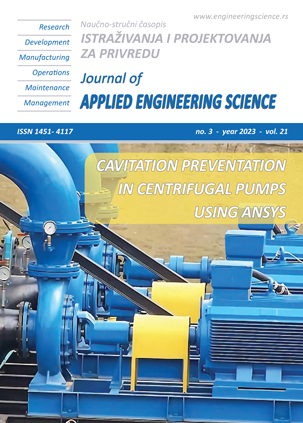PROBABILISTIC MODEL FOR ASSESSING ACCIDENT RATES
Abstract
When working with accident rates, a specialist has to spend quite a lot of time to establish the main places of accidents, certain conditions in which they occurred, which is extremely necessary when determining measures aimed at reducing road accidents. As a result of the research, the authors processed a large amount of data - accident rates for 2015-2021, as a result of which certain dependencies were established between the considered indicators in relative data, which made it possible to develop a probabilistic model for calculating the necessary data with the ability to determine the required conditions. Based on the results obtained, the authors developed an algorithm, according to which procedures were determined when working with accident rates and an assessment of efficiency based on the calculation of the error was carried out. The results obtained allowed us to conclude that the developed probabilistic model and algorithm are effective, in view of the minimum error.
References
Statistics of the State Road Safety Inspectorate (2023). Statistical data of the state traffic police. Available at: http://stat.gibdd.ru/ (date of information retrieval: January 5, 2023).
Badie, M., Shaaban, F. (2021). Diagnosing the statistical rates of traffic accidents in Dohuk Governorate during the period (2011-2020). Qubahan Academic Journal, 1(2), 47–54. https://doi.org/10.48161/qaj.v1n2a42.
Petrashenko, O., Yefymenko, R. (2021) Analysis of seasonal changes of accident level on the roads of state importance and their impact on road accidents statistics. Roads and bridges, vol.. 24,169–176.
Kurakina, E., Evtiukov, S. (2020) Systemic indicators of road infrastructure at accident clusters. Architecture and Engineering, vol. 5 (1), 51-58.
Savolainen, P., Mannering, F. (2011) The statistical analysis of highway crash-injury severities: A review and assessment of methodological alternatives. Accid. Anal. Prev, vol. 43, 1666–1676.
Kumar, S., Toshniwal, D. (2015) A data mining framework to analyze road accident data. J. Big Data, vol. 2, 2–26.
Bin Islam, M., Kanitpong, K. (2008) Identification of factors in road accidents through in-depth accident analysis. IATSS Res, vol. 32, 58–67.
Chubukov, A.; Kapitanov, V. (2017) Simulation of regional mortality rate in road accidents. Trans. Res. Proc, vol. 20, 112–124.
Kapitanov, V., Monina, O. (2020) Probabilistic assessment of main factors determining the road traffic accident rate in regions of Russia. Transportation Research Procedia, vol. 50, 218-225.
Evtiukov, S., Karelina, M. (2018). A method for multi-criteria evaluation of the complex safety characteristic of a road vehicle. Transportation Research Procedia vol. 36, 149–156. DOI: 10.1016/j.trpro.2018.12.057.
Shevtsova, A.G. (2021) Mathematical analysis of certain road safety indicators in the Russian Federation. The Russian Automobile and Highway Industry Journal. Vol. 18(6), 700-711 https://doi.org/10.26518/2071-7296-2021-18-6-700-711
Belin, M., Hansson, S. (2022). Vision Zero in Sweden: Streaming Through Problems, Politics, and Policies. In: Edvardsson Björnberg. The Vision Zero Handbook. Springer, Cham. https://doi.org/10.1007/978-3-030-23176-7_9-1
Belin, M., Per, T. (2012). Vision zero – A road safety policy innovation. International Journal of Injury Control and Safety Promotion, vol. 19(2), 171–179.;
Andersson, R., Gell, T. (2022). Vision Zero on Fire Safety. In: Edvardsson Björnberg. The Vision Zero Handbook. Springer, Cham. https://doi.org/10.1007/978-3-030-23176-7_44-1
Jamroz, K., Romanowska, A. (2022). Vision Zero in Poland. The Vision Zero Handbook. Springer, Cham. https://doi.org/10.1007/978-3-030-23176-7_14-1
Nguyen, M., Novikov A. (2022) Vision Zero in the mining industry – a review of the application in Russia and Vietnam. Economic relations, vol. 12 (4), 769-782 doi: 10.18334/eo.12.4.116382.
Shevtsova, A. (2021) Validity of Smeed's law in the context of the implementation of the Vision Zero program. The world of transport and technological machines. Vol. 4(75), 49-57, DOI 10.33979/2073-7432-2021-75-4-49-57.
Shevtsova, A., Novikov, A. (2021) Development of an approach to determination of coupling qualities of road covering using weather-climate factor. Journal of Applied Engineering Science vol. 19 (1), 30-36 DOI 10.5937/jaes0-26642.;
Novikov, A., Vasilieva, V. (2020) Development of approach to reduce number of accidents caused by drivers. Transportation Research Procedia, vol. 50, 491-498 DOI 10.1016/j.trpro.2020.10.090;
Petrov, A., Evtiukov, S. (2019) Statistical Modelling of Orderliness of Regional Road Safety Provision Systems. IOP Conference Series: Earth and Environmental Science:Current Problems and Solutions, vol. 224 (1), 012033 DOI 10.1088/1755-1315/224/1/012033.
Novikov, A., Zyryanov, V. (2018) Dynamic traffic re-routing as a method of reducing the congestion level of road network elements. Journal of Applied Engineering Science vol. 16 (1), 70-74 DOI 10.5937/jaes16-15289.

